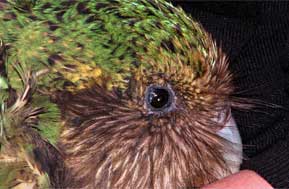Kākāpō males 'boom' on as legendary bird dies
A legendary kākāpō which played a vital role in the recovery of the species has been found dead.
The kākāpō Richard Henry was believed to be more than 80 years old when he passed away of natural causes. The bird was named after a Victorian conservationist who pioneered work with kakapo recovery.
The bird was originally discovered in Fiordland in 1975 when kākāpō were believed to be extinct. When a group of other birds were found on Stewart Island, Richard Henry played a vital role by offering genetic diversity to the breeding programme, which now numbers 121 birds.
The Department of Conservation’s Kākāpō Programme Scientist Ron Moorhouse said that his death marks the end of an era in kākāpō conservation.
“Richard Henry was a living link to the early days of kākāpō recovery, and perhaps even to a time before stoats when kakapo could boom unmolested in Fiordland,” said Dr Moorhouse.
Richard Henry had not bred since 1999, and had been showing signs of age including blindness in one eye, slow moving and wrinkles. A sample of his DNA has been preserved.
The kākāpō breeding season is now well under way on both Codfish and Anchor Islands. If chicks are hatched on Anchor, they could well be the first kākāpō chicks in Fiordland since Richard Henry himself was a chick.
“We had a great year last year when 33 chicks were born, and we’re hoping for more this year. The males are booming well, so we’re optimistic,” said Dr Moorhouse. “It’s sad to lose Richard Henry but the main thing is that the kākāpō population is growing and includes Richard Henry’s genetic legacy of three adult offspring.”
It is hoped that the first eggs of the season will start to appear in February.
The Kākāpō Recovery Programme, backed by Rio Tinto Alcan NZ Ltd, NZ Aluminium Smelters Ltd and Forest & Bird, is DOC’s longest running conservation partnership. When it began in 1990, the kākāpō population was 49.
For more details about Richard Henry and the Kakapo Recovery Programme see www.kakaporecovery.org.nz or www.doc.govt.nz

